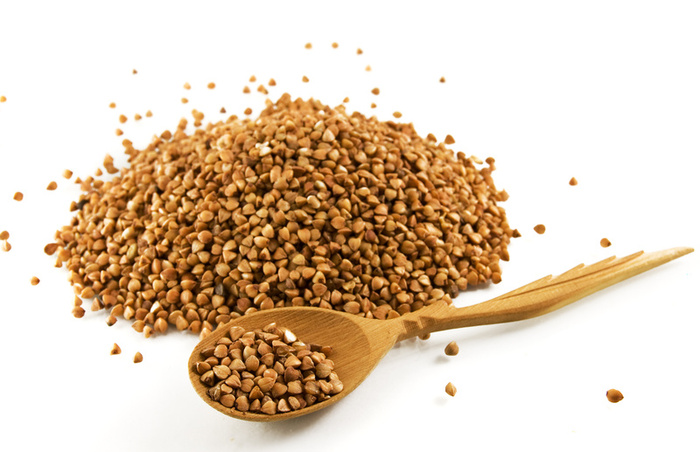Buckwheat is a super seed with numerous health advantages for people on a plant-based diet. In this article, we look at buckwheat and what are the benefits of buckwheat.
What is Buckwheat?
Buckwheat is a seed that belongs to the pseudo grain food group [1]. These are seeds consumed like cereal gains. However, they do not grow on grasses. There are other pseudocereals, for example quinoa and amaranth.
Buckwheat, despite its name, is not related to wheat. The seed is also gluten-free.
The seed has also seen a rise in popularity and is an ingredient in many recipes.
There are two types of buckwheat: Common and Tartary. The primary producers of buckwheat are Kazakhstan, China and Central/Eastern Europe.
8 Buckwheat Benefits
There are many buckwheat benefits that support wellness. And it can be a great addition to a daily, plant-based diet.
1. It is Gluten Free
Buckwheat is in the rhubarb family. So it is gluten-free. And while it is packed full of great nutrients, it is also easily digested. Buckwheat is a good food source for a plant-based diet avoiding gluten.
2. Gut Health
One of the best buckwheat benefits is the cleansing of the gut it can provide. In addition, it can strengthen your gut health, allowing you to have fewer problems digesting other foods.
3. Rich in Fiber
Buckwheat is very high in fiber, specifically insoluble fiber and resistant starch. Both insoluble fiber and resistant starch have benefits for gut health. They fuel the beneficial bacteria found in the gut that help them increase the number of by-products valuable for gut health.
4. It Prevents Constipation
Constipation is one of the highest digestion complaints people on a western diet have. Constipation is often associated with fats (like oils) and salts that are common within this diet [2]. NSAIDs can cause constipation along with other side effects that NSAIDs can cause.
Buckwheat is a natural way to avoid constipation. It reduces transit time in the digestive system. Research has found that it could reduce cancer incidence [3].
5. Antioxidants
Buckwheat is full of antioxidants that include rutin. Rutin is known for its anti-inflammatory properties. It can treat neurological diseases [4]. It can also prevent hemorrhoids and prevent blood clotting.
6. Buckwheat Benefits from Lots of Vitamins and Minerals
Buckwheat naturally contains lots of vitamins and minerals, including B vitamins. These are complex vitamins that aid the function of the body by helping enzymes to undertake vital roles. For instance, they can help with releasing energy and breaking down amino acids. They’re also known to help enzymes transport oxygen and energy-filled nutrients around the body.
Buckwheat is also known to contain copper. Copper is an essential part of a healthy diet. When combined with foods high in iron, the body can form healthy red blood cells. There is evidence that low copper diets can result in numerous health issues such as cardiovascular and osteoporosis [5].
Buckwheat also contains magnesium. This mineral is required for more than 300 enzyme systems within the body with a wide range of benefits from muscle and nerve functions to blood pressure regulation [6].
7. Reduces Cholesterol and Hypertension
Due to the number of minerals and vitamins in buckwheat, those who regularly add the plant to their diets can benefit from a wide range of health benefits.
For instance, buckwheat is known to reduce cholesterol and hypertension. Hypertension is the cause of 13.5% of deaths worldwide [7].
8. Improves the Circulatory System
Buckwheat is known to improve the red blood count, reduce blood pressure and improve the transport of oxygen, energy and nutrients across the body. Therefore, people can feel more energized by an improved circulatory system.
Getting the Buckwheat Benefits into a Daily Diet
Numerous people on the Paddison Program for Rheumatoid Arthritis have found ways to add buckwheat into their diet. Charlotte adds buckwheat to help with inflammation. Brooke also added buckwheat regularly to her rheumatoid arthritis diet.
The benefits of buckwheat can be part of a daily diet in many ways. Buckwheat is a healthy option at any time of the day. Some recipes are particularly good for buckwheat, which are tasty and nutrient full. For instance, breakfasts can include:
- Fresh fruit with buckwheat sprinkled over it.
- Buckwheat power porridge
- Buckwheat pancakes
For lunch, diets can include buckwheat salads with a sweet potato or sprinkled as a salad topping.
And then for dinner, buckwheat meals could include the Paddison Program’s three-grain mix, tofu salad with buckwheat Soba noodles or the spicy buckwheat salad.
References
[1] Giménez-Bastida JA, Zieliński H. Buckwheat as a Functional Food and Its Effects on Health. J Agric Food Chem. 2015 Sep 16;63(36):7896-913. doi: 10.1021/acs.jafc.5b02498. Epub 2015 Sep 3. PMID: 26270637.
[2] Rollet M, Bohn T, Vahid F, On Behalf Of The Oriscav Working Group. Association between Dietary Factors and Constipation in Adults Living in Luxembourg and Taking Part in the ORISCAV-LUX 2 Survey. Nutrients. 2021;14(1):122. Published 2021 Dec 28. doi:10.3390/nu14010122
[3] Kim JY, Son BK, Lee SS. Effects of adlay, buckwheat, and barley on transit time and the antioxidative system in obesity induced rats. Nutr Res Pract. 2012;6(3):208-212. doi:10.4162/nrp.2012.6.3.208
[4] Enogieru AB, Haylett W, Hiss DC, Bardien S, Ekpo OE. Rutin as a Potent Antioxidant: Implications for Neurodegenerative Disorders. Oxid Med Cell Longev. 2018 Jun 27;2018:6241017. doi: 10.1155/2018/6241017. PMID: 30050657; PMCID: PMC6040293.
[5] Klevay LM. Lack of a recommended dietary allowance for copper may be hazardous to your health. J Am Coll Nutr. 1998 Aug;17(4):322-6. doi: 10.1080/07315724.1998.10718769. PMID: 9710839.
[6] Razzaque MS. Magnesium: Are We Consuming Enough? Nutrients. 2018 Dec 2;10(12):1863. doi: 10.3390/nu10121863. PMID: 30513803; PMCID: PMC6316205.
[7] Arima H, Barzi F, Chalmers J. Mortality patterns in hypertension. J Hypertens. 2011 Dec;29 Suppl 1:S3-7. doi: 10.1097/01.hjh.0000410246.59221.b1. PMID: 22157565.

